The Raman Spectra of Co-, Fe-, and Mn-doped Bi2Se3 Single Crystals
Abstract
:1. Introduction
2. Experimental
3. Results and Discussion
4. Conclusions
Author Contributions
Funding
Data Availability Statement
Conflicts of Interest
References
- Ge, Z.H.; Qin, P.; He, D.S.; Chong, X.Y.; Feng, D.; Ji, Y.H.; Feng, J.; He, J.Q. Highly Enhanced Thermoelectric Properties of Bi/Bi2S3 Nanocomposites. ACS Appl. Mater. Interfaces 2017, 9, 4828–4834. [Google Scholar] [CrossRef]
- Luo, X.; Sullivan, M.B.; Quek, S.Y. First-principles investigations of the atomic, electronic, and thermoelectric properties of equilibrium and strained Bi2Se3 and Bi2Te3 including van der Waals interactions. Phys. Rev. B 2012, 86, 184111. [Google Scholar] [CrossRef] [Green Version]
- Jing, Y.; Huang, S.Y.; Zhang, K.; Wu, J.Y.; Guo, Y.F.; Peng, H.L.; Liu, Z.F.; Xu, H.Q. Weak antilocalization and electron-electron interaction in coupled multiple-channel transport in a Bi2Se3 thin film. Nanoscale 2016, 8, 1879–1885. [Google Scholar] [CrossRef] [PubMed] [Green Version]
- Nakajima, S. The crystal structure of Bi2Te3−xSex. J. Phys. Chem. Solids 1963, 24, 479–485. [Google Scholar] [CrossRef]
- Checkelsky, J.G.; Hor, Y.S.; Cava, R.J.; Ong, N.P. Bulk band gap and surface state conduction observed in voltage-tuned crystals of the topological insulator Bi2Se3. Phys. Rev. Lett. 2011, 106, 196801. [Google Scholar] [CrossRef] [Green Version]
- Park, J.Y.; Lee, G.-H.; Jo, J.; Cheng, A.K.; Yoon, H.; Watanabe, K.; Taniguchi, T.; Kim, M.; Kim, P.; Yi, G.-C. Molecular beam epitaxial growth and electronic transport properties of high-quality topological insulator Bi2Se3 thin films on hexagonal boron nitride. 2D Mater. 2016, 3, 035029. [Google Scholar] [CrossRef]
- Zhang, Y.; He, K.; Chang, C.Z.; Song, C.L.; Wang, L.L.; Chen, X.; Jia, J.F.; Fang, Z.; Dai, X.; Shan, W.Y.; et al. Crossover of Three-Dimensional Topological Insulator of Bi2Se3 to the Two-Dimensional Limit. Nat. Phys. 2010, 6, 584–588. [Google Scholar] [CrossRef] [Green Version]
- In, C.; Sim, S.; Kim, B.; Bae, H.; Jung, H.; Jang, W.; Son, M.; Moon, J.; Salehi, M.; Seo, S.Y.; et al. Control over Electron–Phonon Interaction by Dirac Plasmon Engineering in the Bi2Se3 Topological Insulator. Nano Lett. 2018, 18, 734–739. [Google Scholar] [CrossRef] [PubMed]
- Gnezdilov, V.; Pashkevich, Y.G.; Berger, H.; Pomjakushina, E.; Conder, K.; Lemmens, P. Helical fluctuations in the Raman response of the topological insulator Bi2Se3. Phys. Rev. B 2012, 84, 4388–4396. [Google Scholar] [CrossRef] [Green Version]
- Min, Y.; Roh, J.W.; Yang, H.; Park, M.; Kim, S.I.; Hwang, S.; Lee, S.M.; Lee, K.H.; Jeong, U. Surfactant-free scalable synthesis of Bi2Te3 and Bi2Se3 nanoflakes and enhanced thermoelectric properties of their nanocomposites. Adv. Mater. 2013, 25, 1424. [Google Scholar] [CrossRef]
- Viti, L.; Coquillat, D.; Politano, A.; Kokh, K.A.; Aliev, Z.S.; Babanly, M.B.; Tereshchenko, O.E.; Knap, W.; Chulkov, E.V.; Vitiello, M.S. Plasmawave terahertz detection mediated by topological insulators surface states. Nano Lett. 2016, 16, 80–87. [Google Scholar] [CrossRef] [Green Version]
- Irfan, B.; Sahoo, S.; Gaur, A.P.S.; Ahmadi, M.; Guinel, M.J.F.; Katiyar, R.S.; Chatterjee, R. Temperature dependent Raman scattering studies of three dimensional topological insulators Bi2Se3. J. Appl. Phys. 2014, 115, 173506. [Google Scholar] [CrossRef]
- Deshpande, M.P.; Bhatt, S.V.; Sathe, V.; Rao, R.; Chaki, S.H. Pressure and temperature dependence of Raman spectra and their anharmonic effects in Bi2Se3 single crystal. Phys. B Condens. Matter 2014, 433, 72–78. [Google Scholar] [CrossRef]
- Zhu, X.; Santos, L.; Howard, C.; Sankar, R.; Chou, F.C.; Chamon, C.; El-Batanouny, M. Electron-phonon coupling on the surface of the topological insulator Bi2Se3 determined from surface-phonon dispersion measurements. Phys. Rev. Lett. 2012, 108, 185501. [Google Scholar] [CrossRef] [PubMed] [Green Version]
- Hu, J.; Igarashi, K.; Sasagawa, T.; Nakamura, K.G.; Misochko, O.V. Femtosecond study of A1g phonons in the strong 3d topological insulators: From pump-probe to coherent control. Appl. Phys. Lett. 2018, 112, 031901. [Google Scholar] [CrossRef] [Green Version]
- Norimatsu, K.; Hu, J.; Goto, A.; Igarashi, K.; Sasagawa, T.; Nakamura, K.G. Coherent optical phonons in a Bi2Se3 single crystal measured via transient anisotropic reflectivity. Solid State Commun. 2013, 157, 58–61. [Google Scholar] [CrossRef]
- Chen, H.-J.; Wu, K.H.; Luo, C.W.; Uen, T.M.; Juang, J.Y.; Lin, J.-Y.; Kobayashi, T.; Yang, H.-D.; Sankar, R.; Chou, F.C.; et al. Phonon dynamics in CuxBi2Se3 (x = 0, 0.1, 0.125) and Bi2Se2 crystals studied using femtosecond spectroscopy. Appl. Phys. Lett. 2012, 101, 121912. [Google Scholar] [CrossRef] [Green Version]
- Cheng, W.; Ren, S.F. Phonons of single quintuple Bi2Te3 and Bi2Se3 films and bulk materials. Phys. Rev. B 2011, 83, 094301. [Google Scholar] [CrossRef] [Green Version]
- Atuchin, V.V.; Gavrilova, T.A.; Kokh, K.A.; Kuratieva, N.V.; Pervukhina, N.V.; Surovtsev, N.V. Structural and vibrational properties of PVT grown Bi2Te3 microcrystals. Solid State Commun. 2012, 152, 1119–1122. [Google Scholar] [CrossRef]
- Kim, Y.A.; Fujisawa, K.; Muramatsu, H.; Hayashi, T.; Endo, M.; Fujimori, T.; Kaneko, K.; Terrones, M.; Behrends, J.; Eckmann, A.; et al. Raman spectroscopy of boron-doped single-layer graphene. ACS Nano 2012, 6, 6293–6300. [Google Scholar] [CrossRef] [PubMed]
- Bateni, A.; Erdem, E.; Repp, S.; Weber, S.; Somer, M. Al-doped MgB2 materials studied using electron paramagnetic resonance and Raman spectroscopy. Appl. Phys. Lett. 2016, 108, 202601. [Google Scholar] [CrossRef] [Green Version]
- Pinczuk, A.; Abstreiter, G. Spectroscopy of Free Carrier Excitations in Semiconductor Quantum Wells. In Light Scattering in Solids V: Superlattices and Other Microstructures; Springer: Berlin/Heidelberg, Germany; New York, NY, USA, 1989; p. 153. [Google Scholar]
- Eddrief, M.; Atkinson, P.; Etgens, V.; Jusserand, B. Low-temperature Raman fingerprints for few-quintuple layer topological insulator Bi2Se3films epitaxied on GaAs. Nanotechnology 2014, 25, 245701. [Google Scholar] [CrossRef] [PubMed]
- Humlíček, J.; Hemzal, D.; Dubroka, A.; Caha, O.; Steiner, H.; Bauer, G.; Springholz, G. Raman and interband optical spectra of epitaxial layers of thetopological insulators Bi2Te3 and Bi2Se3 on BaF2 substrates. Phys. Scr. 2014, T162, 014007. [Google Scholar] [CrossRef]
- Yang, X.X.; Zhou, Z.F.; Wang, Y.; Jiang, R.; Zheng, W.T.; Sun, C.Q. Raman spectroscopy determination of the Debye temperature and atomic cohesive energy of CdS, CdSe, Bi2Se3, and Sb2Te3 nanostructures. J. Appl. Phys. 2012, 112, 083508. [Google Scholar] [CrossRef]
- Cheng, Y.; Cojocaru-Mirédin, O.; Keutgen, J.; Yu, Y.; Küpers, M.; Schumacher, M.; Golub, P.; Raty, J.Y.; Dronskowski, R.; Wuttig, M. Understanding the Structure and Properties of Sesqui-Chalcogenides (i.e., V2VI3 or Pn2Ch3 (Pn = Pnictogen, Ch = Chalcogen) Compounds) from a Bonding Perspective. Adv. Mater. 2019, 31, 1904316. [Google Scholar] [CrossRef] [PubMed] [Green Version]
- Liu, Q.Y.; Shao, R.H.; Li, N.; Liang, W.Z.; Yang, X.S.; Luo, S.N.; Zhao, Y. Anharmonicity of Bi2Se3 revealed by fs transient optical spectroscopy. Appl. Phys. Lett. 2019, 115, 201902. [Google Scholar] [CrossRef]
- Ren, Z.; Taskin, A.A.; Sasaki, S.; Segawa, K.; Ando, Y. Observations of two-dimensional quantum oscillations and ambipolar transport in the topological insulator Bi2Se3 achieved by Cd doping. Phys. Rev. B 2011, 84, 075316. [Google Scholar] [CrossRef] [Green Version]
- He, R.; Wang, Z.; Qiu, R.L.; Delaney, C.; Beck, B.; Kidd, T.E.; Chancey, C.C.; Gao, X.P.A. Observation of infrared-active modes in Raman scattering from topological insulator nanoplates. Nanotechnology 2012, 23, 455703. [Google Scholar] [CrossRef]
- Lachance, M.H.; Gardner, E.E. Thermoelectric properties of the Bi2Te3 Bi3Se3 isomorphic compound system. Adv. Energy Convers. 1961, 1, 133–138. [Google Scholar] [CrossRef]
- Fu, L.; Kane, C.L. Superconducting Proximity Effect and Majorana Fermions at the Surface of a Topological Insulator. Phys. Rev. Lett. 2008, 100, 096407. [Google Scholar] [CrossRef] [PubMed] [Green Version]
- Chen, Y.L.; Chu, J.H.; Analytis, J.G.; Liu, Z.K.; Igarashi, K.; Kuo, H.H.; Qi, X.L.; Mo, S.K.; Moore, R.G.; Lu, D.H.; et al. Massive Dirac Fermion on the Surface of a Magnetically Doped Topological Insulator. Science 2010, 329, 659–662. [Google Scholar] [CrossRef] [Green Version]
- Sandilands, L.J.; Reijnders, A.A.; Kriener, M.; Segawa, K.; Sasaki, S.; Ando, Y.; Burch, K.S. Doping-dependent charge dynamics in CuxBi2Se3. Phys. Rev. B 2014, 90, 094503. [Google Scholar] [CrossRef] [Green Version]
- Mytilineou, E.; Chao, B.S.; Papadimitriou, D. Raman scattering in sputtered amorphous Ge25Se75−xBix, films. J. Non-Cryst. Solids 1996, 195, 279–285. [Google Scholar] [CrossRef]
- Clark, O.J.; Freyse, F.; Yashina, L.V.; Rader, O.; Sánchez-Barriga, J. Robust behavior and spin-texture stability of the topological surface state in Bi2Se3 upon deposition of gold. NPJ Quantum Mater. 2022, 7, 36. [Google Scholar] [CrossRef]
- Ptok, A.; Kapcia, K.J.; Ciechan, A. Electronic properties of Bi2Se3 dopped by 3d transition metal (Mn, Fe, Co, or Ni) ions. J. Phys. Condens. Matter 2021, 33, 065501. [Google Scholar] [CrossRef]
- Cermak, P.; Ruleova, P.; Holy, V.; Prokleska, J.; Kucek, V.; Palka, K.; Benes, L.; Drasar, C. Thermoelectric and magnetic properties of Cr-doped single crystal Bi2Se3—Search for energy filtering. J. Solid State Chem. 2018, 258, 768–775. [Google Scholar] [CrossRef] [Green Version]
- Zhang, M.; Lv, L.; Wei, Z.T.; Yang, X.S.; Zhao, Y. Electrical and magnetic transport properties of Co-doped Bi2Se3 topological insulator crystals. Int. J. Mod. Phys. B 2014, 28, 145010. [Google Scholar] [CrossRef]
- Lv, L.; Zhang, M.; Wei, Z.T.; Yang, L.Q.; Yang, X.S.; Zhao, Y. Enhanced contribution of surface state and modification of magnetoresistance in FexBi2−xSe3 topological insulator crystals. J. Appl. Phys. 2013, 113, 043923. [Google Scholar] [CrossRef]
- Lv, L.; Zhang, M.; Wei, Z.T.; Yang, L.Q.; Yang, X.S.; Zhao, Y. Magnetoresistance in Topological Insulator MnxBi2-xSe3 Crystals. Int. J. Mod. Phys. B 2013, 27, 1362036. [Google Scholar] [CrossRef]
- Ferrari, A.C.; Basko, D.M. Raman spectroscopy as a versatile tool for studying the properties of graphene. Nat. Nanotechnol 2013, 8, 235–246. [Google Scholar] [CrossRef] [Green Version]
- Kim, D.; Li, Q.; Butch, N.P.; Paglione, J.; Das, S.; Sarma, M.S. Fuhrer, Intrinsic electron-phonon resistivity of Bi2Se3 in the topological regime. Phys. Rev. Lett. 2012, 109, 166801. [Google Scholar] [CrossRef] [Green Version]
- Chen, C.; Xie, Z.J.; Feng, Y.; Yi, H.; Liang, A.; He, S.; Mou, D.; He, J.; Peng, Y.; Liu, X.; et al. Tunable Dirac fermion dynamics in toplological insulators. Sci. Rep. 2013, 3, 2411. [Google Scholar] [CrossRef] [PubMed] [Green Version]
- Blöchl, P.E. Projector augmented-wave method. Phys. Rev. B 1994, 50, 17953. [Google Scholar] [CrossRef] [PubMed] [Green Version]
- Grimme, S.; Antony, J.; Ehrlich, S.; Krieg, H. A consistent and accurate ab initio parametrization of density functional dispersion correction (DFT-D) for the 94 elements H-Pu. J. Chem. Phys. 2010, 132, 154104. [Google Scholar] [CrossRef] [PubMed] [Green Version]
- Grimme, S.; Ehrlich, S.; Goerigk, L. Effect of the damping function in dispersion corrected density functional theory. J. Comput. Chem. 2011, 32, 1456–1465. [Google Scholar] [CrossRef]
- Kriener, M.; Segawa, K.; Ren, Z.; Sasaki, S.; Wada, S.; Kuwabata, S.; Ando, Y. Electrochemical synthesis and superconducting phase diagram of, CuxBi2Se3. Phys. Rev. B 2011, 84, 054513. [Google Scholar] [CrossRef] [Green Version]
- Rench, D.W.; Xu, S.Y.; Flanagan, T.C.; Xu, S.Y.; Kandala, A.; Flanagan, T.C.; Beidenkopf, H.; Yeats, A.L.; Buckley, B.B.; Klimov, P.V.; et al. Interplay between Ferromagnetism, Surface States, and Quantum Corrections in a Magnetically Doped Topological Insulator. Phys. Rev. B 2012, 86, 205127. [Google Scholar]
- Wu, T.M.; Chen, X.; Xie, H.; Chen, Z.N.; Zhang, L.; Pan, Z.J.; Zhuang, W. Coupling of spin-orbit interaction with phonon anharmonicity leads to significant impact on thermoelectricity in SnSe. Nano Energy 2019, 60, 673–679. [Google Scholar] [CrossRef]
- Diéguez, A.; Romano-Rodríguez, A.; Vilà, A.; Morante, J.R. The complete Raman spectrum of nanometric SnO2 particles. J. Appl. Phys. 2001, 90, 1550–1557. [Google Scholar] [CrossRef] [Green Version]
- Yuzyuk, Y.I.; Katiyar, R.S.; Alyoshin, V.A.; Zakharchenko, I.N.; Markov, D.A.; Sviridov, E.V. Stress relaxation in heteroepitaxial (Ba, Sr) TiO3 (001) MgO thin film studied by micro-Raman spectroscopy. Phys. Rev. B 2003, 68, 104104. [Google Scholar] [CrossRef]
- Richter, H.; Wang, Z.P.; Ley, L. The one phonon Raman spectrum in microcrystalline silicon. Solid State Commun. 1981, 39, 625–629. [Google Scholar] [CrossRef]
- Campbell, I.H.; Fauchet, P.M. The effects of microcrystal size and shape on the one phonon Raman spectra of crystalline semiconductors. Solid State Commun. 1986, 58, 739–741. [Google Scholar] [CrossRef]
- Richter, W.; Becker, C.R. A Raman and far-infrared investigation of phonons in the rhombohedral V2–VI3 compounds Bi2Te3, Bi2Se3, Sb2Te3 and Bi2(Te1−xSex)3 (0 < x < 1), (Bi1−ySby)2Te3 (0 < y < 1). Phys. Status Solidi 1977, 84, 619–628. [Google Scholar]
- Choi, Y.H.; Jo, N.H.; Lee, K.J.; Yoon, J.B.; You, C.Y.; Jung, M.H. Transport and magnetic properties of Cr-, Fe-, Cu-doped topological insulators. J. Appl. Phys. 2011, 109, 07E312. [Google Scholar] [CrossRef]
- Choi, J.; Lee, H.W.; Kim, B.S. Mn-doped V2VI3 semiconductors: Single crystal growth and magnetic properties. J. Appl. Phys. 2005, 97, 10D324. [Google Scholar] [CrossRef]
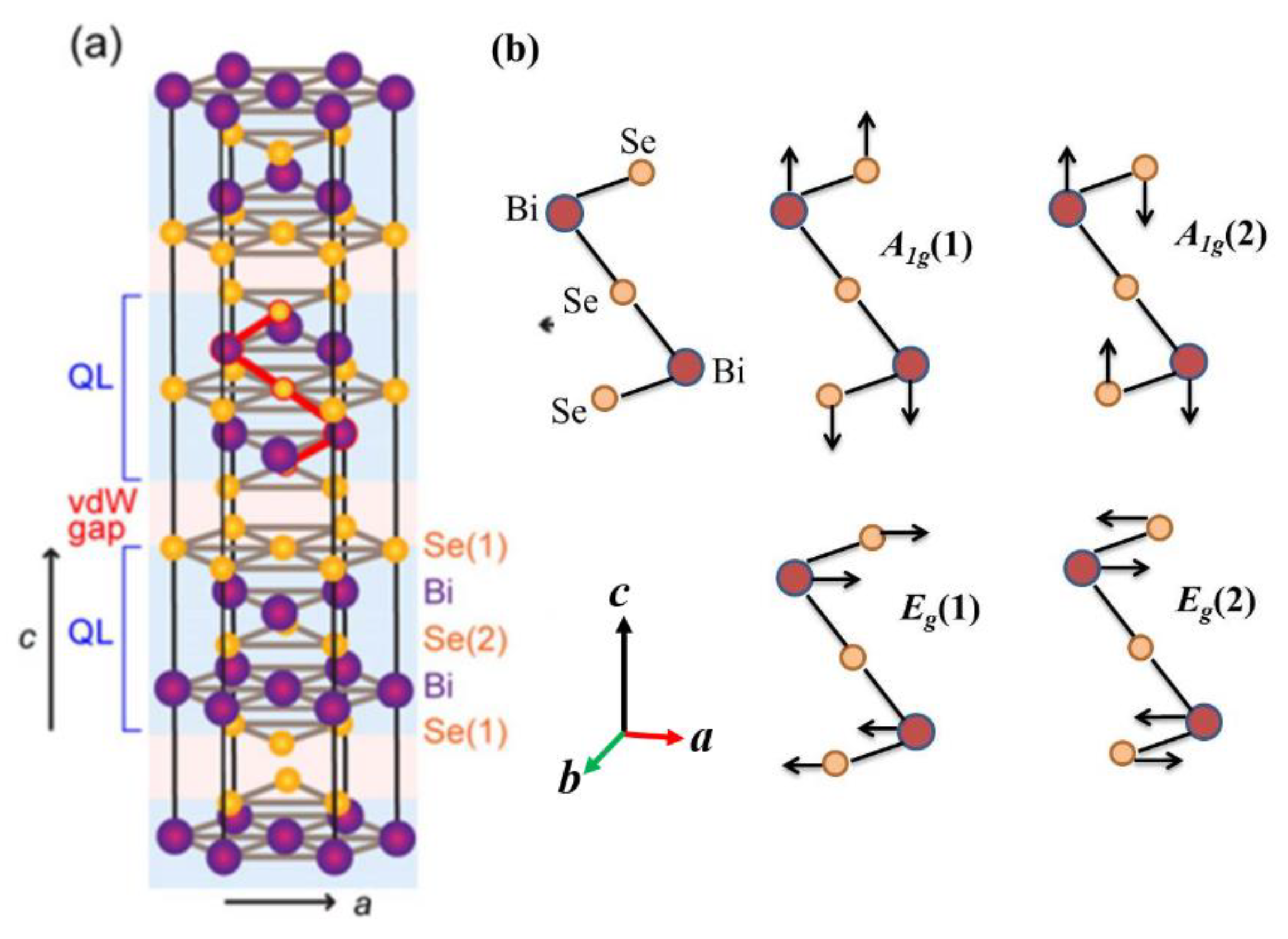
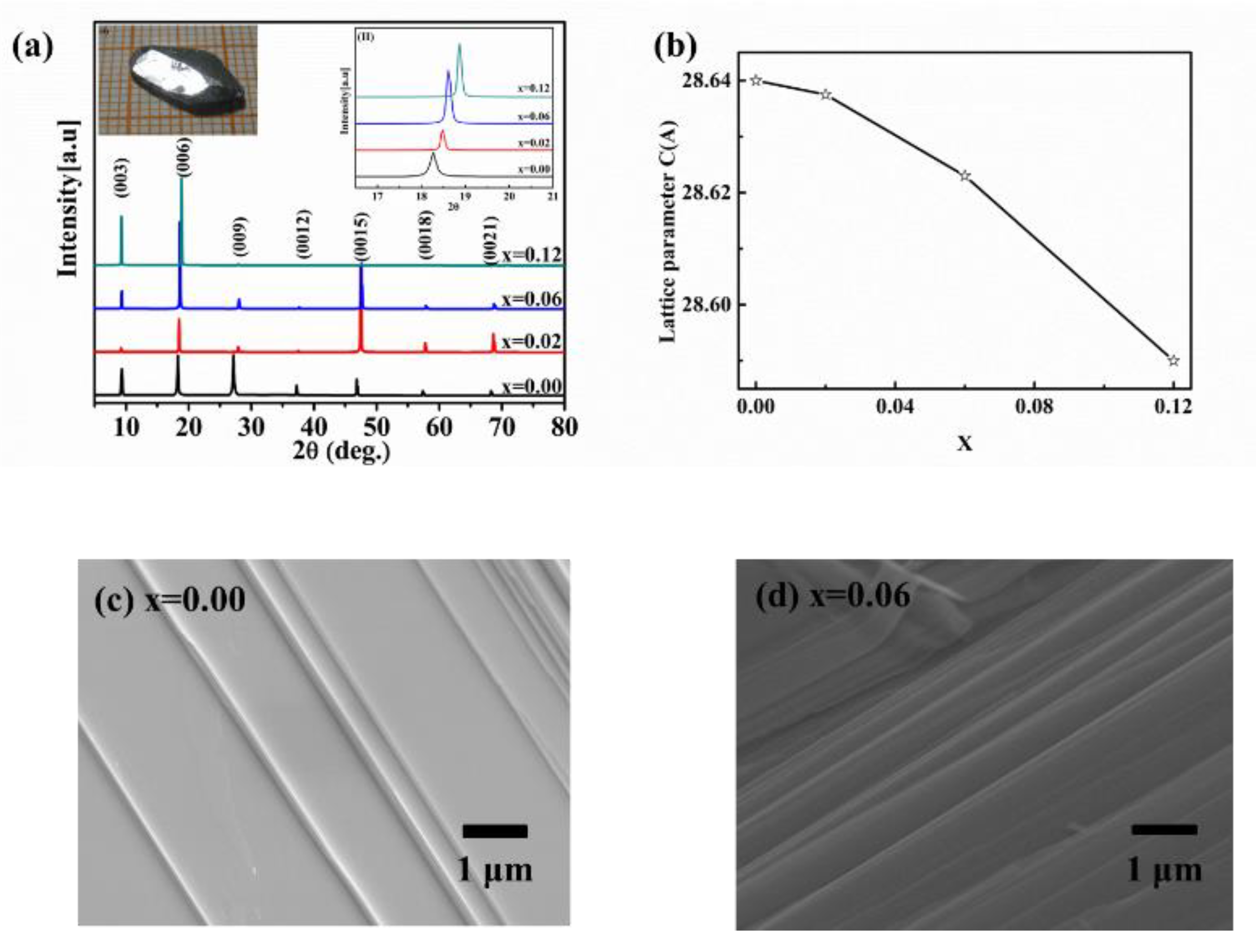
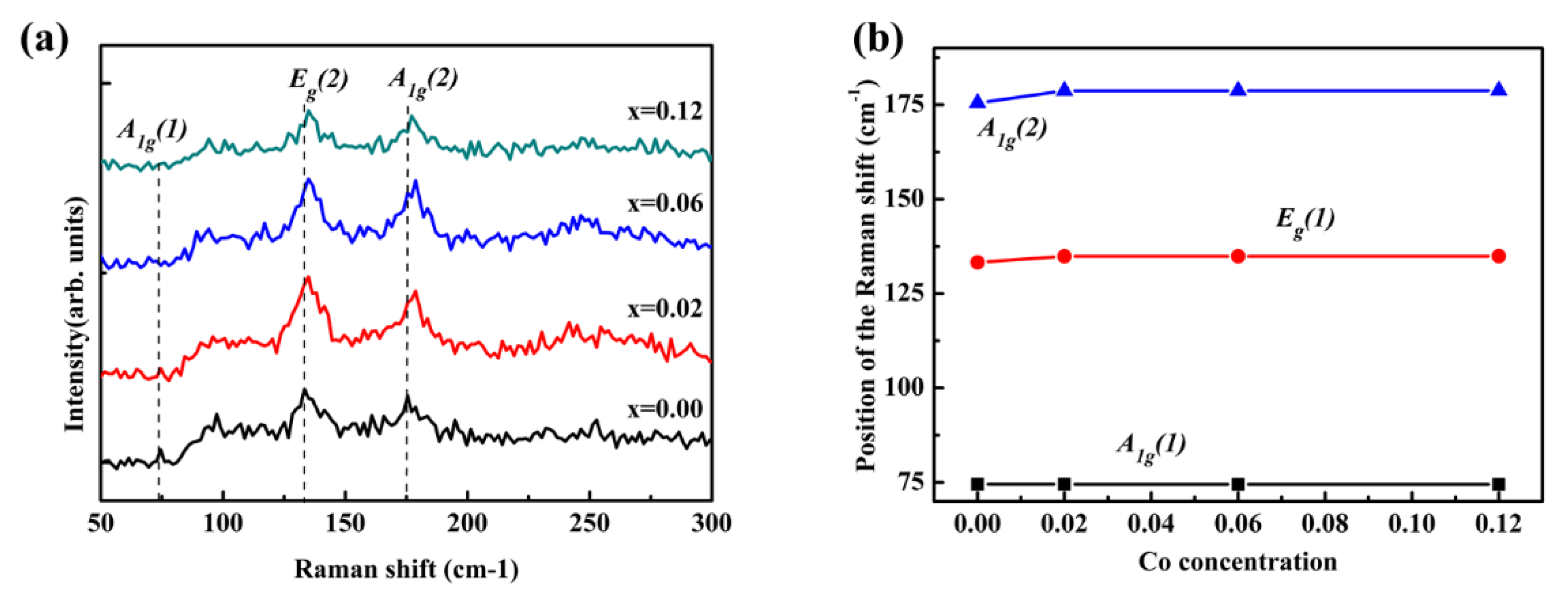
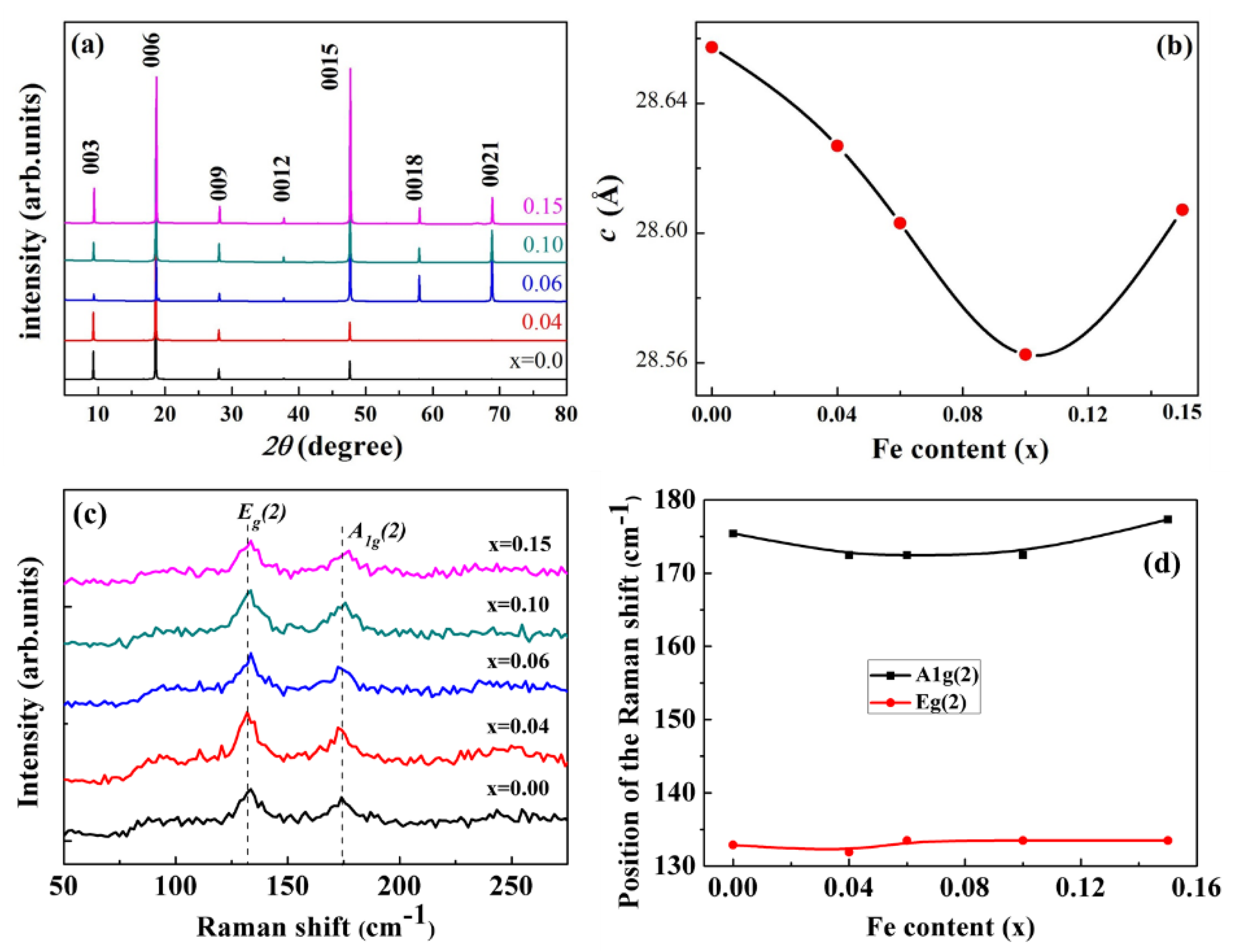

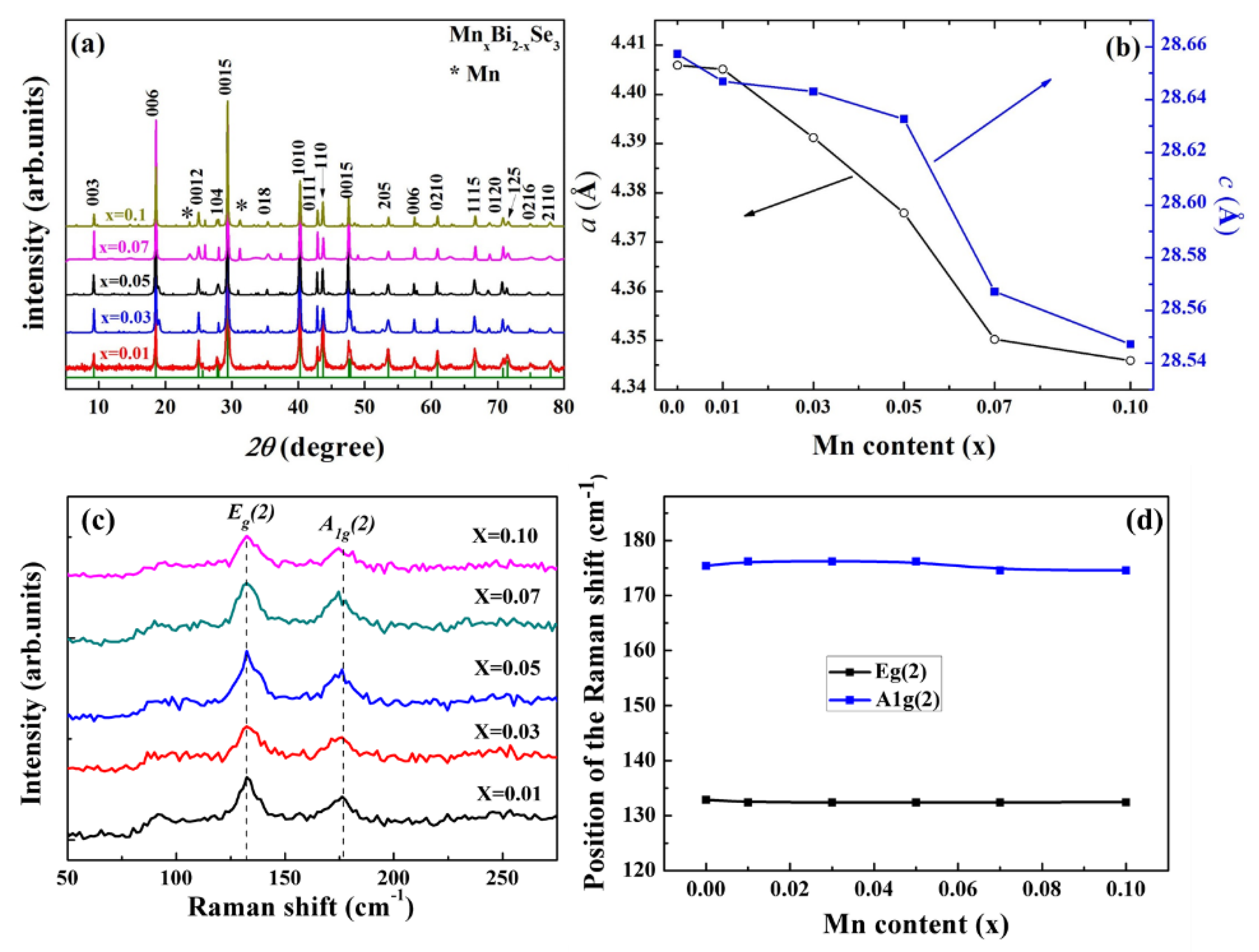
Disclaimer/Publisher’s Note: The statements, opinions and data contained in all publications are solely those of the individual author(s) and contributor(s) and not of MDPI and/or the editor(s). MDPI and/or the editor(s) disclaim responsibility for any injury to people or property resulting from any ideas, methods, instructions or products referred to in the content. |
© 2023 by the authors. Licensee MDPI, Basel, Switzerland. This article is an open access article distributed under the terms and conditions of the Creative Commons Attribution (CC BY) license (https://creativecommons.org/licenses/by/4.0/).
Share and Cite
Liu, L.; Zhang, M.; Liu, Q. The Raman Spectra of Co-, Fe-, and Mn-doped Bi2Se3 Single Crystals. Crystals 2023, 13, 456. https://doi.org/10.3390/cryst13030456
Liu L, Zhang M, Liu Q. The Raman Spectra of Co-, Fe-, and Mn-doped Bi2Se3 Single Crystals. Crystals. 2023; 13(3):456. https://doi.org/10.3390/cryst13030456
Chicago/Turabian StyleLiu, Ligang, Min Zhang, and Qiya Liu. 2023. "The Raman Spectra of Co-, Fe-, and Mn-doped Bi2Se3 Single Crystals" Crystals 13, no. 3: 456. https://doi.org/10.3390/cryst13030456





